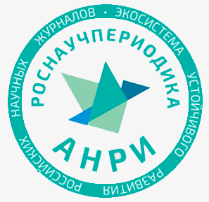ОПЫТ ПРИМЕНЕНИЯ КОРРЕЛЯЦИОННО-РЕГРЕССИОННОГО АНАЛИЗА В ИССЛЕДОВАНИИ ЗАБОЛЕВАЕМОСТИ ДЕТЕЙ В ВОЗРАСТЕ 0-14 ЛЕТ
Аннотация
В статье рассмотрены социально-значимые вопросы, связанные с выявлением большого числа детей с различными заболеваниями. Целью данной работы был анализ динамики изменения числа детей в возрасте 0–14 лет с пониженной остротой зрения, с дефектами речи, с пониженной остротой слуха, со сколиозом и с нарушениями осанки в РФ за 35 лет, выявить закономерности и общие тенденции. Построить прогноз динамики изменения данных заболеваний у детей. Актуальность работы заключается в том, что проблема, связанная с большим количеством выявленных случаев заболеваемости у детей в возрасте 0–14 лет, является важной, без анализа и решения которой очень сложно развивать наше государство. Методика основана на использовании корреляционно-регрессионного анализа. Полученные данные говорят о том, что построенные модели носят полиномиальный характер. В работе рассмотрены факторы, которые предположительно могут оказывать влияние на прирост заболеваемости у детей. Авторы к таким факторам отнесли: заболеваемость населения по основным классам болезней, число родившихся детей больными или заболевшими (масса тела 1000 г и более), заболеваемость населения алкоголизмом и алкогольными психозами, заболеваемостью населения болезнями характеризующиеся повышенным кровяным давлением и заболеваемость населения злокачественными новообразованиями. Полученные расчеты показали, что в соответствии с прогнозами произойдет рост числа детей в возрасте 0–14 лет с пониженной остротой зрения и слуха и с нарушениями осанки на 53,9%, 35,5% и 37,2% соответственно к 2023 г., по сравнению с данными показателями за 2015 г. В то же самое время число детей в возрасте 0–14 лет с дефектами речи и со сколиозом, снизится на 27,5% и 11,4% соответственно 2023 г., по сравнению с данными показателями за 2015 г.
Литература
2. Zueva N.V., Semerikova N.A., Panfilova Yu.N. Preventive monitoring of the health status of children and adolescents in a children's polyclinic. Prospects for the development of the outpatient link of the pediatric service. From-in. "Pen". Moscow. 2019. P. 72-79. (in Russian).
3. List of studies during preventive medical examinations. Practice of a pediatrician. Moscow. 2016. N 5. P. 57-59. (in Russian).
4. The procedure for minors to undergo medical examinations, including when entering educational institutions and during the period of study in them. Reproductive health of children and adolescents. Moscow. 2013. N 6. P. 52-76.
5. Afanasyev V.N. Statistical analysis of the influence of factors on the morbidity of the child population in the Orenburg region. Science of data. From-in. SPSEU (Saint Petersburg). 2020. P. 28
6. Albitsky V.Yu. Social factor in the formation of the health of a Russian teenager. Public health and healthcare. Kazan. 2005. N 3-4 (7-8). P. 10-13. (in Russian).
7. Albitsky V.Yu., Modestov A.A., Yakovleva T.V., Mendelevich B.D. Preventability of health losses of the child population - an effective resource-saving strategy in healthcare. Social aspects of population health. 2010. N 4 (16). 14 p. (in Russian).
8. Yaseneva I.A., Yaseneva E.V. Morbidity of children as an indicator of the ecological situation in Sevastopol. Intercarto. Intergis. 2020. V. 26. N 3. P. 62-77. (in Russian).
9. Maksimova T.M., Belov V.B., Lushkina N.P. The state of health, living conditions and medical support of children in Russia. M.: Iz-vo. PerSe. 2008. 367 p. (in Russian).
10. Ignatov E.I., Aseeva E.V., Aseeva I.A. Natural and anthropogenic environmental factors and children's health of the Crimea. Use and protection of natural resources in Russia. M. 2016. N 1 (145). P. 72-75. (in Russian).
11. Khabriev R.U., Mingazova E.N., Shigabutdinov T.N., Mansurova R.G. Dynamics of the main indicators of morbidity of population of the Republic of Tatarstan. Public health and health care. Kazan. 2020. N 2 (66). P. 5-10. (in Russian).
12. Khabriev R.U., Mingazova E.N. Physical development of children as the main indicator of the state of health and a criterion for the effectiveness of medical and social security. Pediatrics and pediatric surgery in the Volga Federal District. From-in. Medical publishing house "Praktika". 2017. P. 92-93. (in Russian).
13. Pinaev S.K., Torshin V.I., Radysh I.V., Chizhov A.Ya., Pinaeva O.G. Environmental factors associated with fluctuations in the frequency of neoplasms in children. Human ecology. Arkhangelsk. 2021. N 6. P. 49-57. (in Russian).
14. Aghajanyan N.A., Chizhov A.Ya., Kim T.A. Diseases of civilization. Human ecology. Arkhangelsk. 2003. N 4. P. 8-11.
15. Pinaev S.K., Kustov V.I., Kosykh N.E. Approaches to the study of the frequency of benign tumors in the pediatric population. Questions of oncology. 1992. N 8. P. 969-974. (in Russian).
16. Bantyeva M.N., Manoshkina E.M., Sokolovskaya T.A., Matveev E.N. Trends in morbidity and dynamics of chronization of pathology in children 0-14 years old in the Russian Federation. Social aspects of population health. Moscow. 2019. V. 65. N 5 10 p.
17. Levchenko O.V., Gerasimov A.N., Kuchma V.R. The influence of socio-economic factors on the morbidity of children and adolescents with socially significant and main classes of diseases. Public health and habitat. 2018. N 8 (35). P. 21-25. (in Russian).
18. Federal State Statistics Service: official website. https://rosstat.gov.ru/folder/13721 (accessed: 1.08.2021).
19. Kulentsan A.L., Marchuk N.A. Analysis of the dynamics of morbidity of the population with socially significant diseases in the Russian Federation. Izvestia of higher educational institutions. Series: Economics, finance and production management. 2020. N 3 (45). P. 67-70. (in Russian).
20. Kulentsan A.L., Marchuk N.A. Analysis of the morbidity of the children's population of the Russian Federation. Modern Science. Moskva. 2021. N 8. P. 147-149. (in Russian).
21. Marchuk N.A., Kulentsan A.L. Influence of pollutants on morbidity in the Southern Federal District. Modern high-tech technologies. Regional application. 2020. N 3 (63). P. 129-138.














